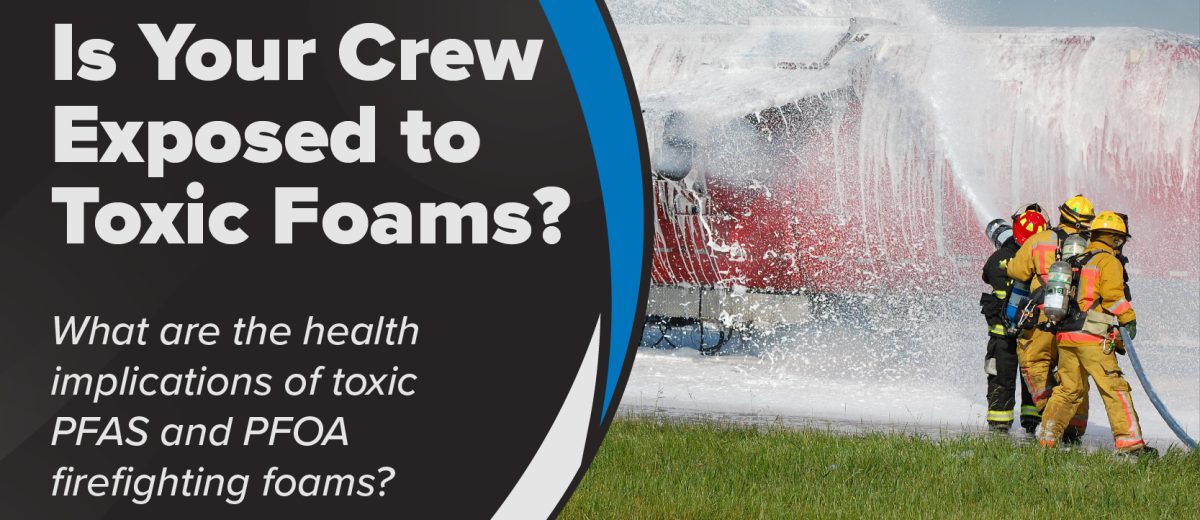How Does Toxic PFAS and PFOA Firefighting Foam Affect Your Firefighting Crew?
What is Firefighting Foam?
PFOS (Perfluorooctane Sulfonate) and PFOA (Perfluorooctanoic acid) are chemicals used to make items resistant to water. These chemicals were historically found in many items like cookware and clothing. PFOS and PFOA have also been used in firefighting foams intended to put out petroleum-based fires. They are commonly found in Aqueous Film Forming Foam (AFFF) which are used in the fire service, at petroleum and chemical facilities, and even airports throughout the world.
A Brief Overview of Firefighting Foam History
Early 1900s: The first chemical firefighting foams were created and used to fight large, difficult to extinguish oil fires.
1960s: Aqueous Film Forming Foam began being widely used. This era of AFFF had high concentrations of PFOS and were applied to fight fires involving jet fuels and other flammable liquids. The issue is that PFOS and PFOAs do not break down over time. This raised serious concerns about its effects on the environment, drinking water, and the health of those using it.
2000s: As we learned of the negative effects that concentrated amounts of PFOS and PFOA chemicals have on the environment, the companies that originally produced the chemicals began to phase out production. However, without regulation, some companies halted production while others continued to make these firefighting foams.
Today: Many governments have implemented strict regulations for the use of firefighting foams that have toxic PFOS and PFOA chemicals. Manufacturers have developed fluorine free foams (F3) for fire suppression and companies are developing best-practice application procedures to maximize firefighters’ ability to suppress fires efficiently.
What are the Health Implications of Exposure to Toxic Firefighting Foam?
In 2012, Emory University scientists studied individuals who had worked and been exposed to toxic foams at a DuPont factory. The scientists found an increased risk of chronic kidney disease and mesothelioma that was three times that of individuals who had not been exposed. The EPA also linked other diseases and issues to toxic firefighting foam exposure.
Illnesses Linked to Toxic Firefighting Foam Exposure include:
-
Multiple Myelomas
-
Mesothelioma
-
Diabetes Mellitus Type 2
-
Kidney Cancer and non-cancerous kidney diseases
-
Low birth weights
-
Accelerated puberty
-
Skeletal variations
-
Liver effects such as tissue damage
-
Immune effects such as antibody production and immunities
-
Thyroid effects
-
Cholesterol changes
How Have Firefighting Foam Manufacturers Responded?
Many companies started to conduct their own research. Studies began to show that blood plasma proteins were bound to by PFOS and PFOA compounds. A 1981 finding by 3M stated that the chemicals caused birth defects in rats. By the 1990s manufacturers were aware that these toxic chemicals could cause lab animals to develop liver tumors and cancer in their pancreas. By 2006, eight manufacturers around the world had unanimously agreed to cease production of PFOS and PFOA chemicals.
What Can You Do to Protect Your Firefighting Crew from Toxic Exposure?
Exposure at low levels of these potentially toxic chemicals has much less expectation of human harm. Due to the high concentrations of PFOS and PFOA chemicals found in firefighting foam, firefighters who have worked in direct contact with toxic aqueous film-forming foam are at a higher risk of developing illnesses related to exposure. There are steps you can take to lower or eliminate continued risks for your firefighter crew associated with exposure, though.
The best way to eliminate future exposure is to eliminate the use of fluorine-based foams and switch your station to a fluorine-free foam. While there are some technical application adjustments that need to be made to maximize the discharge for fire suppression, it is easily achievable. Our sales and customer service teams are happy to make recommendations and help you find the right products for your firefighting foam application needs.
